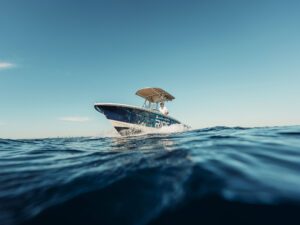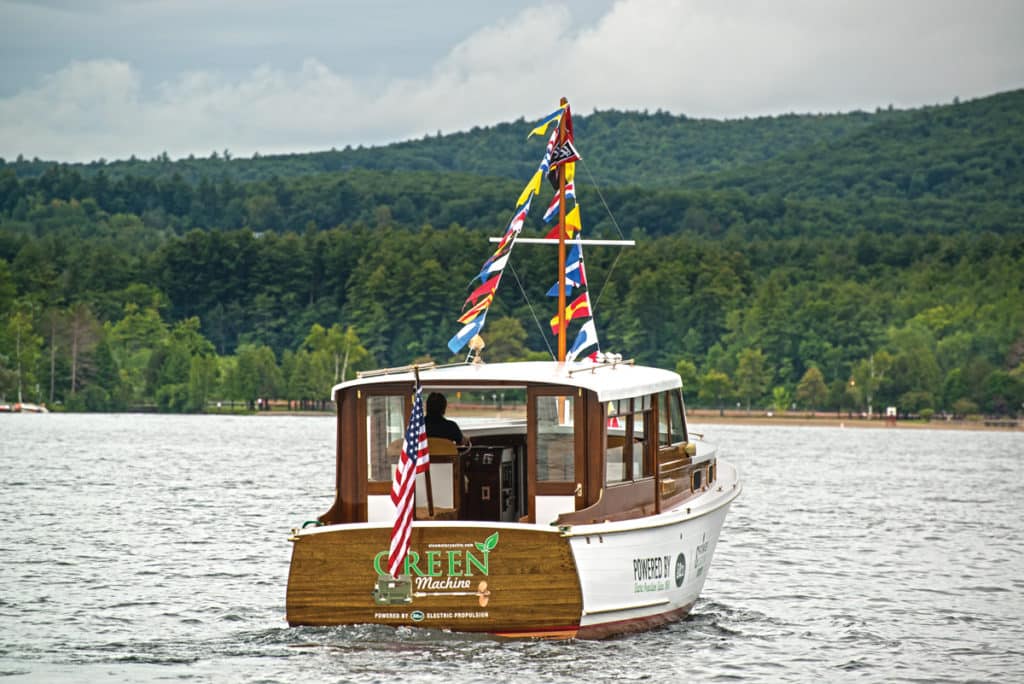
Electric motors and battery capacity will exceed the horsepower and range of gas engines and a tank full of fuel. When that happens, internal combustion engines may vanish as quickly as a stack of $20s at the gas dock. How soon will that happen? Likely before first-graders today are ready to buy their first boat, and possibly before they’re in college.
Says who? We went aboard electric boats and talked to industry insiders for the scoop on electric boating’s future. Come aboard as we explore 100 years of electric boat development.

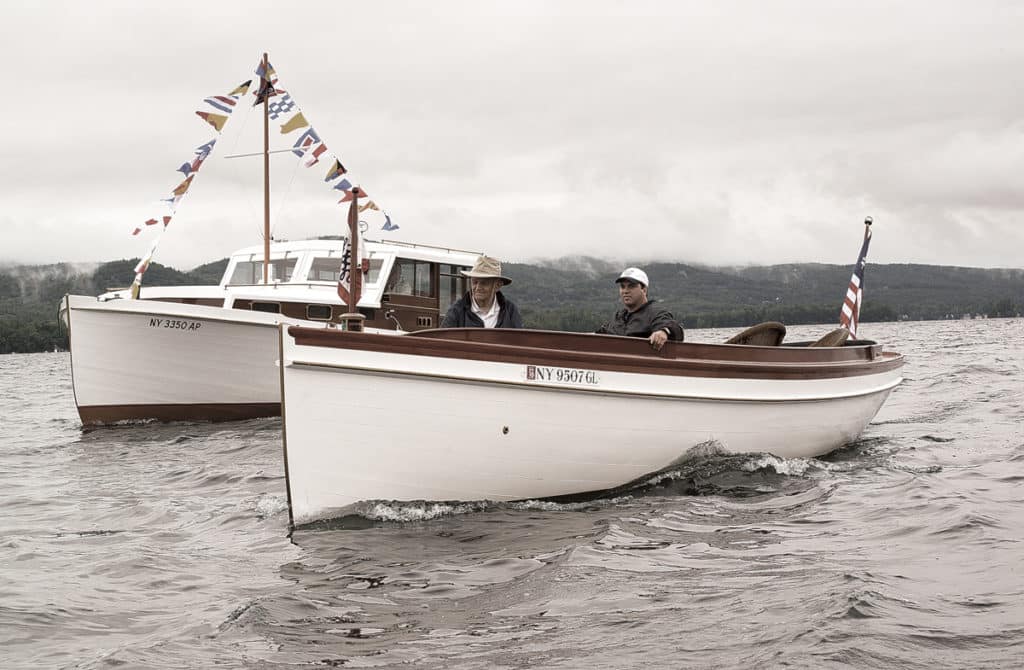
In the Beginning
“Over a period of 30 years, boats went through five different methods of propulsion: steam, naphtha, electric, gasoline and diesel,” exclaims Joseph Fleming, the head of engineering for Elco, builders of electric boats and propulsion systems. But practical, safe motorboating began at the 1893 Chicago World’s Fair, where 55 electric launches ferried attendees. The fair was the first-ever large-scale use of electricity. “At the time, electric boats were most practical,” Fleming says.
Consider Wenona, a 32-foot launch built in 1899 by the Electric Launch Co. — now Elco — the company that built those World’s Fair launches. A 5 hp electric motor pushed Wenona at 7 mph for more than 60 miles between charges without smoke, soot, noise or open flame.
What happened to electric-powered boats? Gottlieb Daimler invented the high-speed gasoline engine, which he used in 1886 to propel a 15-foot skiff along at 7 mph — the first gas-powered boat, and Rudolf Diesel ran his first successful prototype engine in 1893. “By the end of World War I, gasoline engines became the preferred propulsion for boats,” Fleming says. At the time, boats could go faster and farther on liquid fuel than they could on batteries.
VIDEO! We ski behind an electric boat!
A century later, the tide may be swinging away from fuel. Elco recently restored a 34-foot 1941 Cruisette. When built, the original 125 hp Chrysler gasoline engine pushed Green Machine to 16 mph, and now the new 70-horsepower-equivalent Elco electric motor’s practical cruising speed is 8 mph — clearly not performance that lands a boat on the cover of Boating. However, some motors on Elco’s drawing board can exceed Green Machine‘s original gas engine’s performance. What’s the holdup? Batteries. Fleming calculates the boat would go 9.4 miles at 16 mph using her bank of 18 24-amp-hour, absorbed glass mat (AGM) batteries.
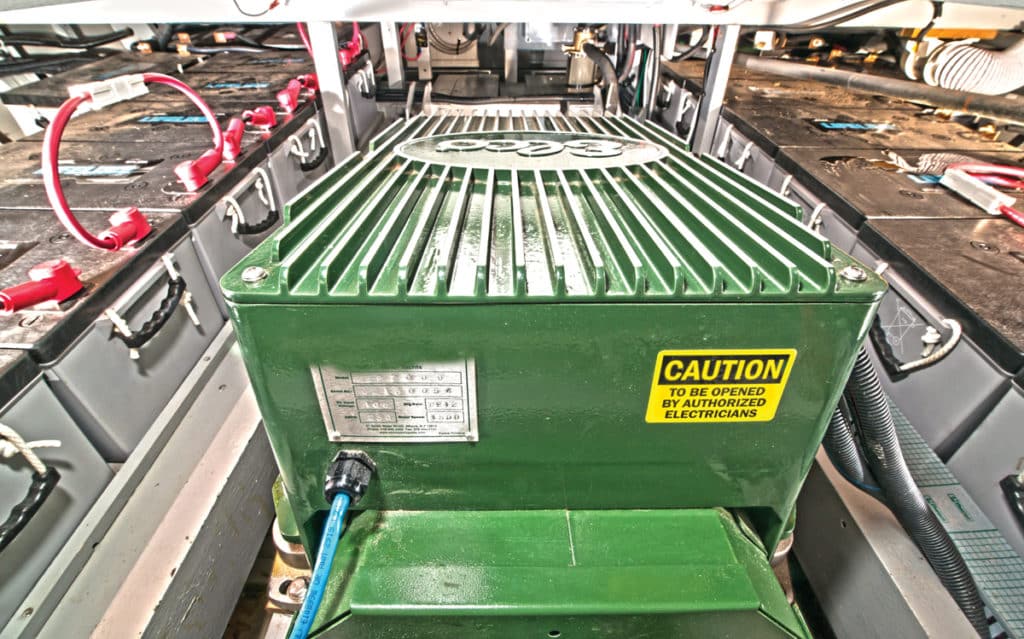
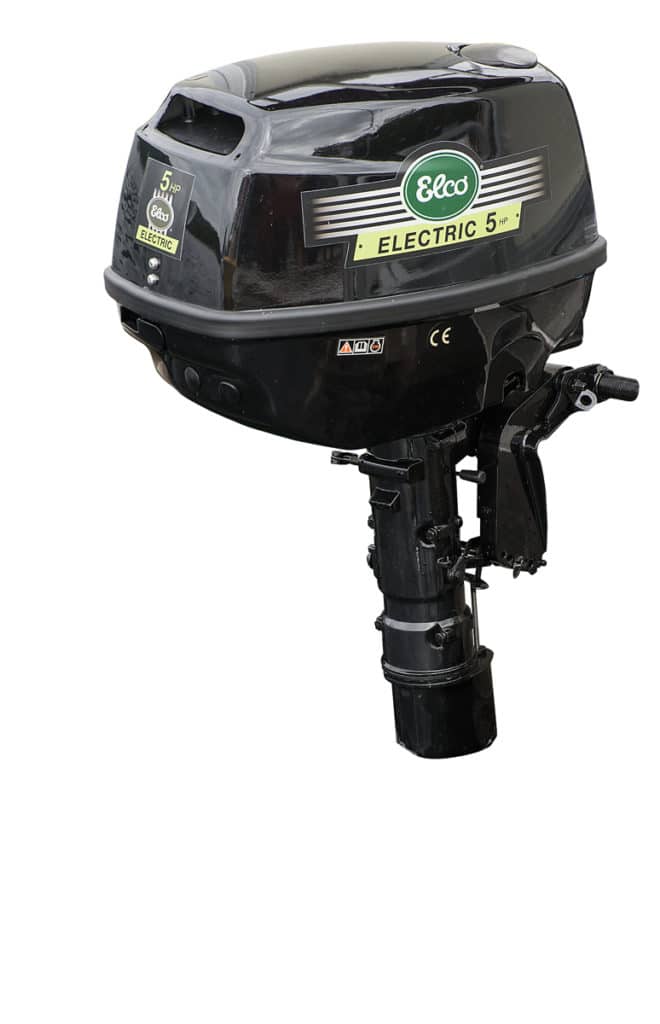
Power to the People
“We reached the capacity of lead-acid technology 50 years ago,” says Daan Hobbelen, who heads the power storage labs at Mastervolt, makers of marine batteries, chargers, inverters and propulsion systems. “We can make lead-acid better for starting, better for storage, lower maintenance, but there isn’t much we can do to add power density.” Lithium iron phosphate (LiFePO4), currently the best alternative, more than doubles Green Machine‘s range to 20.4 miles using batteries weighing the same as her existing AGM batteries. “Production improvements should increase energy density another 40 percent, and the cost will come down,” Hobbelen says.
Lithium sulfur (Li-S) is the upcoming battery technology, currently with about double the energy density of LiFePO4. Hobbelen expects cost-effective production within five years, and he anticipates double that capacity — four times today’s best lithium batteries — in 10 years. That would extend Green Machine‘s 16 mph range past 80 miles.
Learn about electric hybrid marine propulsion.
Five hours of cruising time clearly isn’t acceptable, but just as diesel engines became lighter — 50 percent more horsepower per pound just in the past 20 years — electric motors will be lighter too. “We can hit one horsepower per pound,” Fleming says. Green Machine‘s existing Elco motor weighs 10 times that. (Modern diesels average 1.5 pounds per horsepower.) Increased horsepower for the same weight motor allows boats to carry more batteries, extending range, increasing speed or both. Doubling the weight of Green Machine‘s batteries requires just 20 percent more horsepower to maintain performance, so with expected battery technology, in 10 years that should be a 160-mile range aboard a 34-foot boat cruising at 16 mph.
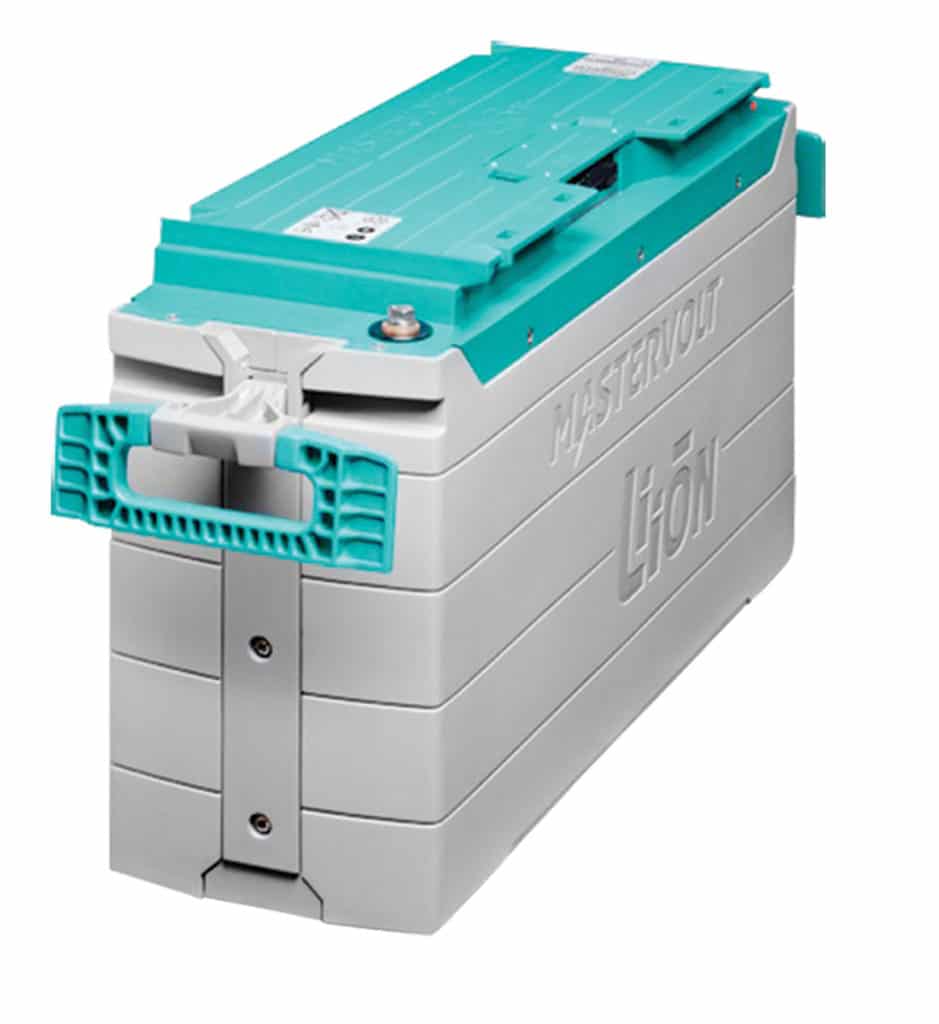
When AGM batteries discharge below 50 percent, or lithium batteries draw below 20 percent, battery life suffers. But boaters routinely run expensive diesel engines above 80 percent load knowing that the engines would last longer if run slower, and that fuel costs per mile go up with increased speed. Drawing AGM batteries to just 20 percent remaining charge or lithium to 10 percent charge is an analogous cost trade-off that most boaters will likely accept. Capt. Vincent Daniello
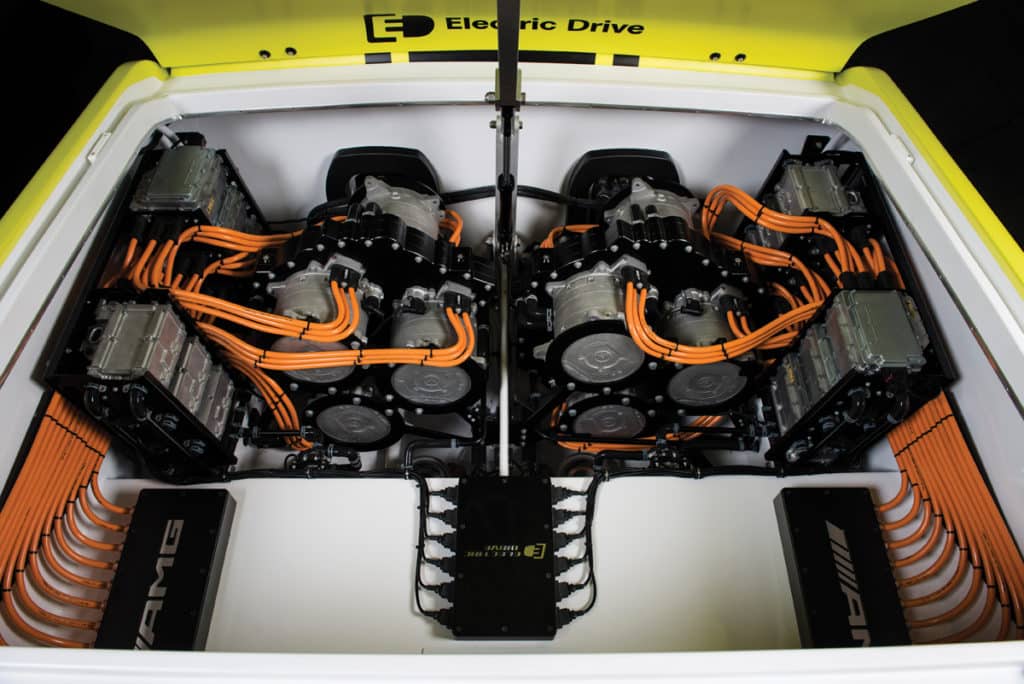
Admittedly, 16 mph won’t cut it for many boaters. How about 120 mph? Cigarette’s 38 Top Gun powered by Mercedes AMG electric propulsion makes 2,220 horsepower. Four behemoth, liquid-cooled lithium-ion batteries provide the boat with 240 kilowatt-hours of storage — the equivalent of a 5 kW generator running for 48 hours. But the boat’s range would be more easily calculated with a stopwatch than a GPS — 7.3 minutes for 14.6 miles at 120 mph.
Even lithium sulfur leaves an electric Top Gun’s range at less than 50 miles — 25 percent of the 200-mile wide-open-throttle range at 85 mph of a gas-powered 38 Top Gun. What closes the gap? “Lithium air promises about 10 times the energy of lithium batteries we have today,” says Christoph Ballin, who co-founded Torqeedo, pioneering maker of electric marine motors. “Once that can be produced economically, electric propulsion will take hold as quickly as digital cameras took over film.”
Lithium-air (Li-air) batteries are already being produced in small numbers, and electric propulsion technology is progressing quickly. “When we started Torqeedo in 2005, there wasn’t a single electric outboard using brushless motors or a single lithium battery being used,” Ballin says. Before that, pontoon boats and restored classic runabouts on “green” lakes in Europe and the United States were propelled by electric trolling motors. “Their overall efficiency is 15 or 20 percent,” he states. “We’re currently at 56 percent overall efficiency,” Ballin says, with most of those losses in the propeller and lower unit. Today’s electric motors use 98 percent of power consumed to turn the shaft, and that efficiency holds over most of their operating rpm range. Even the century-old Wenona applies 80 percent of its battery power to the propeller shaft. Gasoline engines today are around 25 percent efficient before drive and propeller losses, though liquid fuel’s greater power density — the energy it packs into a given volume — still makes up for that over batteries. Electric motors are projected to be much smaller than gas engines too — an outboard of the future won’t be much larger than a lower unit today. Motors contained belowdecks free cockpit space, and pods might contain the motors completely within their lower units, freeing space below.
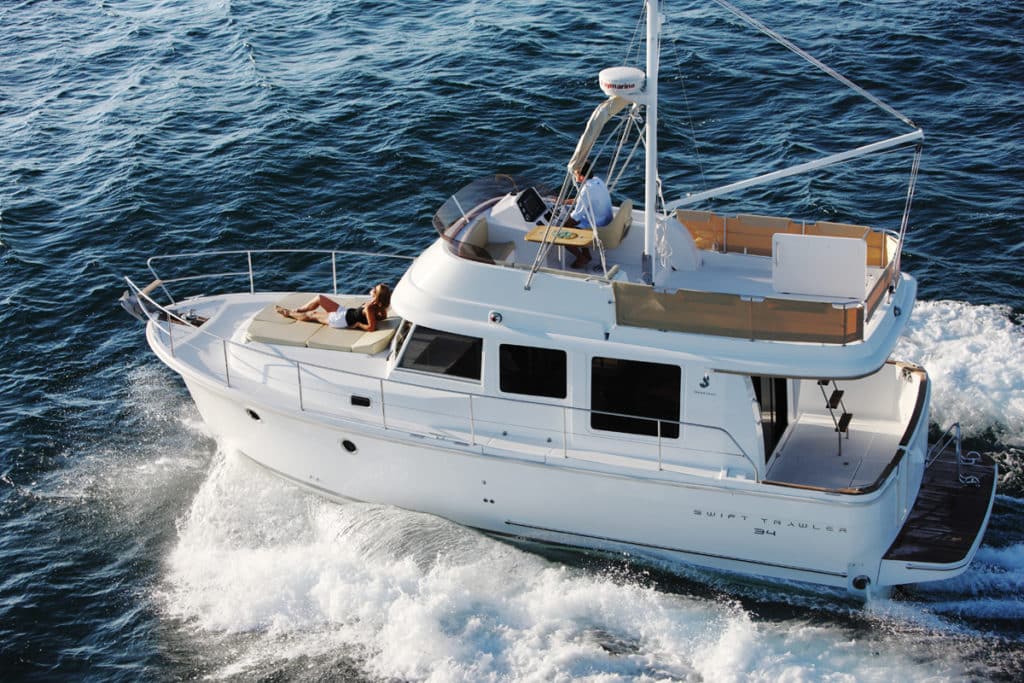
Cost Benefit Analysis
Even the high price of current lithium batteries may favor electric boats, say the experts. “Calendar life of lithium batteries is 20 years,” Hobbelen says, compared with about five years for AGM. “If you compare life cycles, AGM can expect 500 cycles at 50 percent discharge. Lithium ion exceeds 2,000 cycles at 80 percent discharge. Cost over a battery’s kilowatt-hours during its life is lower on lithium than it is with AGM.”
What about charging time? “From 95 percent state of charge down to about 10 percent, lithium produces a very constant chemical reaction,” Hobbelen says, which means little lost to heat, even under high power demand. Conversely, Hobbelen adds, “You can charge a bank of lithium batteries to 95 percent of full charge in about 20 minutes.” The 440 volts required is readily available on streetside power poles. “The automobile industry is facing similar rapid-charging issues,” Hobbelen says. “It’s likely marinas will use those automotive solutions.” The American Boat and Yacht Council (ABYC) is already contemplating safety standards for 400-volt DC systems that will drive and charge electric boats.
Maintenance might be another nail in the gas-engine coffin. When refurbished three years ago, Wenona‘s original, 116-year-old electric motor needed little work. Elco claims 50,000 hours essentially maintenance-free from its current, three-phase, alternating current motors. Torqeedo claims about the same for its brushless DC system. Of the limiting factor, Ballin says: “The electronics that control the motor will be able to start and stop maybe 50,000 times,” far outlasting most boats. High-voltage, incredibly high-amperage DC systems do require vigilance, though. “Have the system inspected every two years or 200 hours,” Ballin advises.
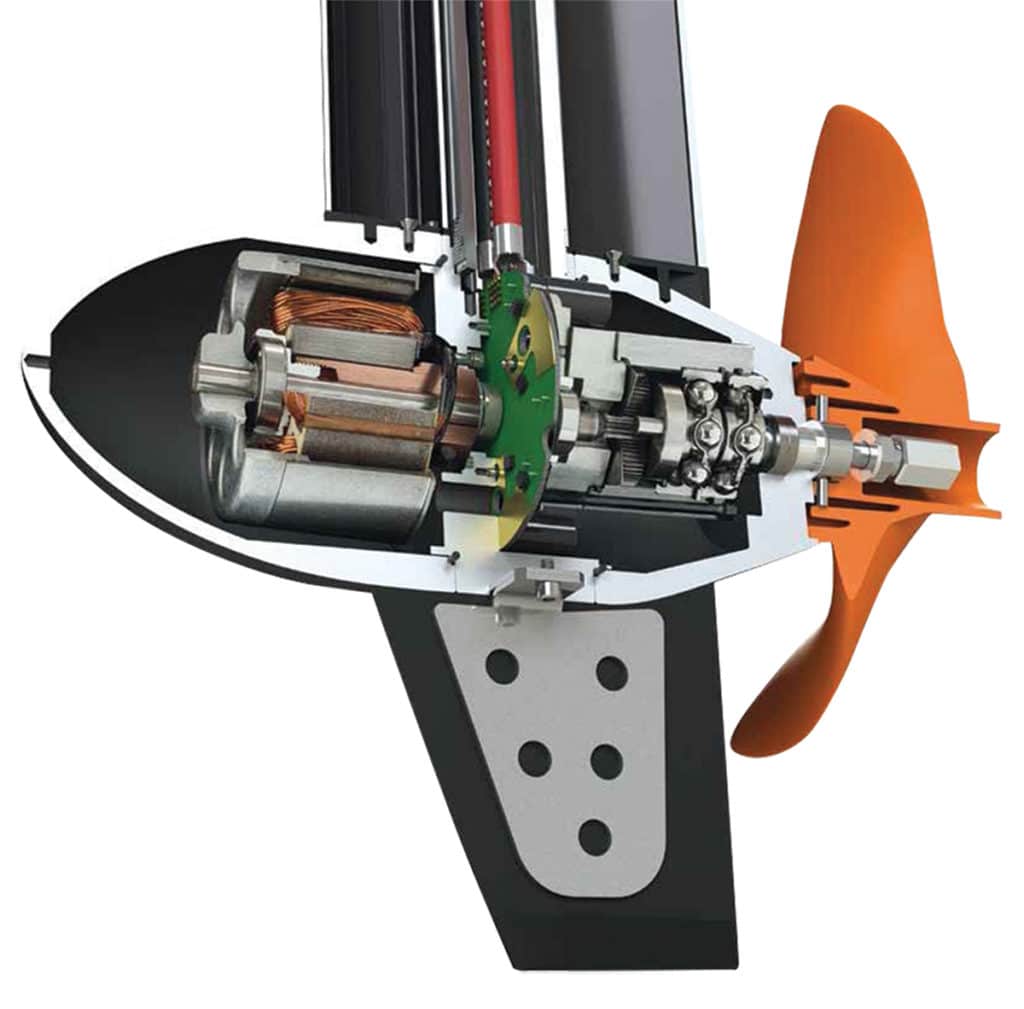
Both Elco’s three-phase, alternating-current motors and Torqeedo’s brushless, direct-current motors are driven by an alternating-current magnetic field. Direct-current battery power goes through an inverter that varies AC frequency to regulate motor speed, with full torque down to 1 rpm, and also controls propeller direction, negating the need for marine transmissions. In older technology, brushed direct-current motor speed is varied by changing voltage, and power is physically carried through brushes to a commutator, which increases maintenance and decreases efficiency. Boating Magazine
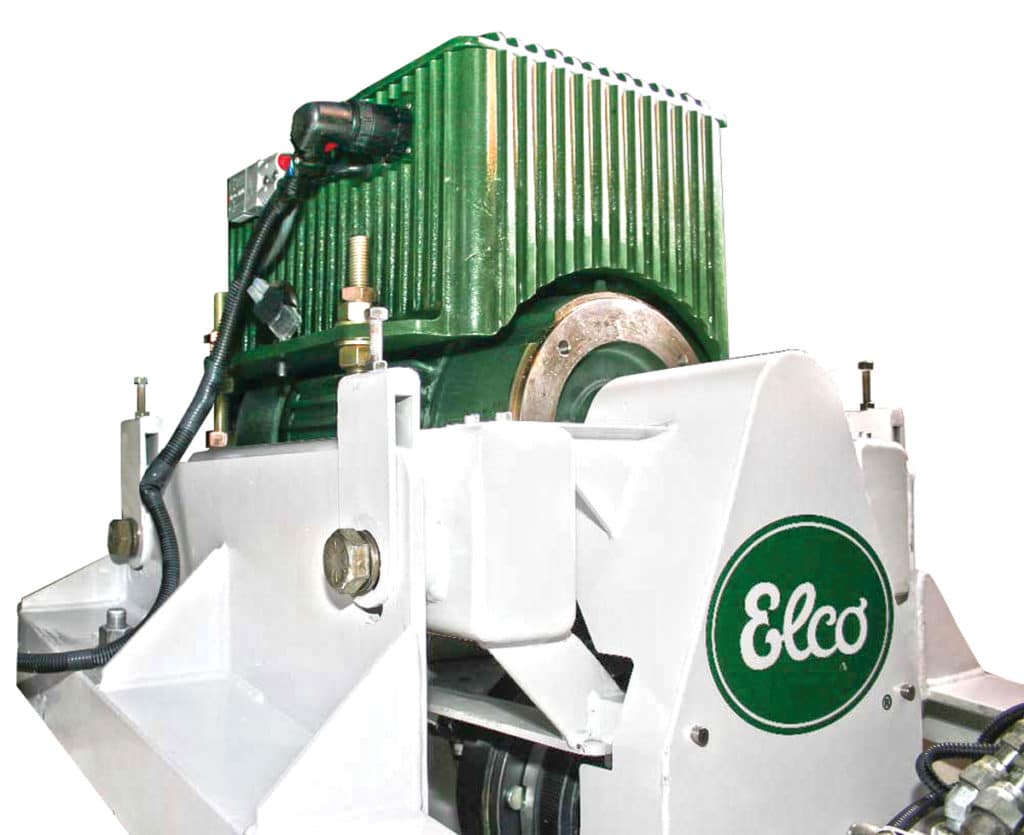
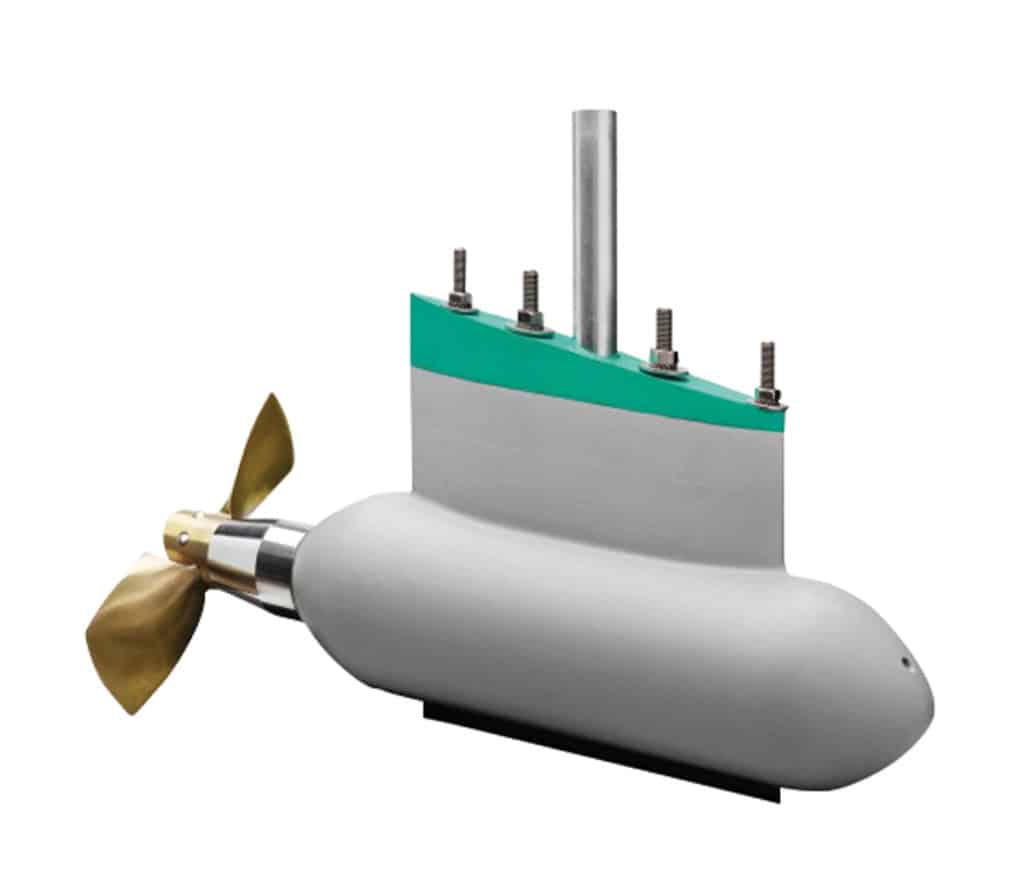
Switch Hitters
So where does that leave electric powerboats now? Parallel hybrids provide the means to go fast on internal combustion engines while using electric power for slow cruising. Serial hybrids extend electric-motor range using generators to charge batteries. Beneteau’s prototype 34 Swift Trawler, Current Affairs, is actually both. The boat’s standard 425 hp Cummins diesel inboard provides cruising at 20 mph, while an Elco 20 hp equivalent electric motor and 12 220-amp-hour AGM batteries push the boat to 5.7 mph for 19 miles. What’s more interesting is that, using about half the output of the boat’s 7.5 kW generator, Current Affairs runs on electricity continuously, without depleting batteries, at 4.5 mph. Conversely, the diesel engine turning the electric motor provides 7.7 kW of alternating current using an inverter, providing redundant backup to the generator’s electric output.
“Not just being green, but from an economic standpoint, there are a few niches where pure electric propulsion makes sense, and others where hybrid makes sense,” Ballin says. “With improvements in battery technology, more of these niches become practical.” Ballin sees a task of our generation is to expand green mobility. “Without affecting our on-the-water activities, we need to make boating cleaner, make it nicer, make it sustainable,” he says. But dollars — making boat propulsion less expensive — may drive that shift to green power as much as advances in battery technology.



